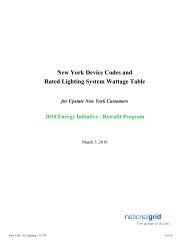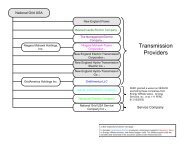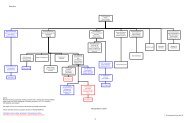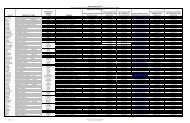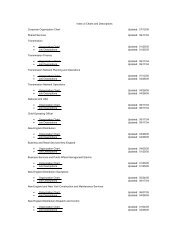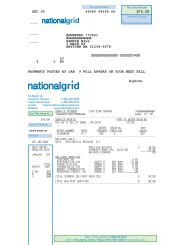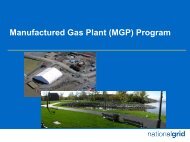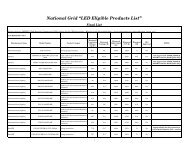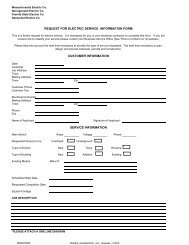January 2012 Capital Investment - National Grid
January 2012 Capital Investment - National Grid
January 2012 Capital Investment - National Grid
You also want an ePaper? Increase the reach of your titles
YUMPU automatically turns print PDFs into web optimized ePapers that Google loves.
Exhibit ___ (EIOP-19)Page 35 of 684such as a circuit breaker manufactured by a particular vendor. These assessmentsfocused on the identification of specific susceptibilities for assets and asset systems andthe development of potential remedies.In light of current economic conditions, however, the Company presents a modifiedapproach in this Plan that reduces near-term capital costs. The result is greater relianceon the purchase of spare equipment to replace damaged equipment that may fail inservice for certain elements of the transmission and distribution system. The modifiedapproach calls for a more targeted replacement of assets based on their conditionversus wholesale replacement based on “end of useful life” criteria, especially fortransmission line refurbishment projects. This approach will result in lower capitalinvestment in the near term, but may present adverse impacts on reliability and safetyperformance as compared to higher investment levels. Closer monitoring of systemperformance as it relates to asset condition causes will be necessary. For overheadlines specifically, the Plan seeks to achieve compliance with NESC requirements, andwill attempt to implement the recommendation from Staff’s recent rate case testimony torefurbish overhead transmission line facilities that are in unacceptably severedeteriorated condition (i.e. Niagara Mohawk’s defined Level 1, Level 2 and Level 3conditions), as opposed to entire lines, unless a compelling justification can be providedfor the full refurbishment. Any overhead line proposed for a refurbishment will undergo afield inspection by qualified transmission line engineers and will usually be supported bycomprehensive aerial inspection using stabilized video cameras. As part of theconceptual engineering process, refurbishment options will be thoroughly evaluated on acase-by-case basis and starting in calendar year <strong>2012</strong>, the engineering economics ofvarious options such as a complete reconductoring versus a life extension will bereviewed. In addition, longer term impacts such as a greater number of visits to thesame right-of-way, multiple site establishment costs, increased susceptibility to stormdamage, additional permitting and licensing costs, greater levels of environmentalimpact, and more disturbance to property abutters, among other things will be evaluatedto determine if it is most economical scope of work for the benefit of customers.Therefore, in the longer term, a more holistic approach to the management of overheadline condition issues may be more appropriate and cost effective.Further detail on specific asset condition programs and projects is given below.3A/3B Tower StrategyThe 3A/3B Towers program was established following a 2003 tower failure whichresulted from an extreme longitudinal wind load generated by a storm. Phase I of theprogram (completed in <strong>January</strong> 2009) was the replacement of 139 transmission towersthat were in service at road and other public crossings and that support the Edic-NewScotland #14 345kV line. The remaining Type 3A and 3B towers on this line will need toundergo periodic climbing inspections to confirm the integrity of the structures. 10 Thereare four other 345kV lines that use these same types of towers. They are the 345kVNew Scotland–Leeds #93 and #94 lines, Athens-Pleasant Valley #91 and Leeds–Pleasant Valley #92 lines. As of 2010, these lines have not experienced any tower10 The 3A/3B Tower Strategy (SG 032) was included as Exhibit 21 in Volume 6 of 9 of theSeptember 17, 2007 Transmission <strong>Capital</strong> <strong>Investment</strong> Plan, Case 06-M-0878.II-1836



